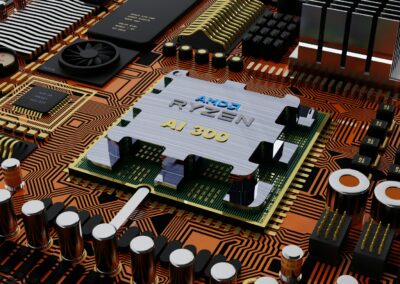Enabling Scalability and Real-Time Participation in the Metaverse
Introduction: The Role of Cloud and Edge Computing in the Metaverse
Advancements in cloud and edge computing for the metaverse are essential to enabling more users to participate in real-time, creating seamless and immersive experiences. In regions like Saudi Arabia, the UAE, Riyadh, and Dubai, where technological innovation is at the forefront, embracing these advancements is vital for driving digital transformation and business success.
The metaverse is envisioned as a virtual world where users can interact, work, and play in real-time. Achieving this vision requires overcoming significant technical challenges, particularly in terms of scalability and performance. Cloud and edge computing technologies provide the necessary infrastructure to address these challenges, ensuring that the metaverse can accommodate a growing number of users while maintaining high levels of performance and responsiveness.
This article explores how advancements in cloud and edge computing support the scalability and performance of the metaverse, enabling more users to participate in real-time. It provides insights for business executives, mid-level managers, and entrepreneurs on the importance of these technologies in shaping the future of the metaverse.
Scalability: Meeting the Demands of a Growing User Base
One of the primary challenges in developing the metaverse is ensuring that it can scale to accommodate millions of users simultaneously. Traditional computing infrastructures are often limited in their capacity to handle such large-scale operations. However, cloud computing offers a solution by providing virtually unlimited resources that can be scaled up or down based on demand.
Cloud computing platforms, such as those offered by AWS, Microsoft Azure, and Google Cloud, enable developers to deploy and manage applications across a distributed network of servers. This approach ensures that the metaverse can handle sudden spikes in user activity without compromising performance. For instance, during a virtual concert or a large-scale event in the metaverse, cloud computing resources can be dynamically allocated to manage the increased load, ensuring a smooth and uninterrupted experience for all participants.
Moreover, the flexibility of cloud computing allows developers to experiment with new features and functionalities without the constraints of physical hardware. This agility is crucial for the continuous evolution of the metaverse, enabling rapid innovation and adaptation to user needs. In regions like Saudi Arabia and the UAE, where there is a strong emphasis on technological leadership, leveraging cloud computing is essential for driving the metaverse’s growth and scalability.
Performance: Enhancing Real-Time Interactions
While cloud computing provides the scalability needed for the metaverse, edge computing addresses the critical aspect of performance. Edge computing involves processing data closer to the source, reducing latency and improving the speed of data transfer. This is particularly important for the metaverse, where real-time interactions are a key component of the user experience.
In a traditional cloud computing model, data must travel from the user’s device to a centralized data center and back, which can introduce latency and slow down interactions. Edge computing, on the other hand, processes data at the edge of the network, closer to where it is generated. This approach minimizes latency, ensuring that users can interact with the metaverse in real-time.
For example, in a virtual reality (VR) environment within the metaverse, edge computing enables more responsive and immersive experiences. When users move or interact with objects, the data is processed locally, resulting in faster feedback and smoother interactions. This level of performance is crucial for maintaining the metaverse’s immersive quality and keeping users engaged.
Enabling Real-Time Participation: The Power of Combined Technologies
The combination of cloud and edge computing creates a powerful infrastructure that supports real-time participation in the metaverse. Cloud computing provides the scalability needed to handle large numbers of users, while edge computing ensures the performance necessary for real-time interactions. Together, these technologies enable the metaverse to deliver seamless and immersive experiences to users around the world.
In regions like Riyadh and Dubai, where there is a strong focus on innovation and digital transformation, adopting cloud and edge computing is essential for realizing the full potential of the metaverse. These technologies not only enhance the user experience but also open up new opportunities for businesses to engage with customers in novel ways. For instance, companies can create virtual showrooms, host interactive events, and offer personalized experiences that were previously unimaginable.
Furthermore, the integration of artificial intelligence (AI), blockchain, and generative AI with cloud and edge computing can further enhance the capabilities of the metaverse. AI can be used to create intelligent and adaptive environments, blockchain can ensure the security and integrity of transactions, and generative AI can generate dynamic content that keeps users engaged. These technologies, combined with cloud and edge computing, create a robust foundation for the future of the metaverse.
Conclusion: The Future of the Metaverse with Cloud and Edge Computing
As the metaverse continues to evolve, advancements in cloud and edge computing will play a pivotal role in its development. These technologies provide the scalability and performance necessary to support real-time participation, ensuring that the metaverse can accommodate a growing user base while delivering immersive and engaging experiences.
For business executives, mid-level managers, and entrepreneurs in regions like Saudi Arabia, the UAE, Riyadh, and Dubai, understanding and embracing these technologies is crucial for staying competitive in the digital age. By leveraging the power of cloud and edge computing, businesses can unlock new opportunities for growth, innovation, and customer engagement.
The integration of artificial intelligence, blockchain, and generative AI with cloud and edge computing further enhances the potential of the metaverse, creating a dynamic and interactive environment that can transform industries and redefine the way we interact with the digital world. As we look to the future, the metaverse, powered by advancements in cloud and edge computing, promises to be a cornerstone of the next era of digital transformation.
#CloudComputing #EdgeComputing #Metaverse #Scalability #Performance #RealTimeParticipation #SaudiArabia #UAE #Riyadh #Dubai #ArtificialIntelligence #Blockchain #GenerativeAI #BusinessSuccess #Leadership #ManagementSkills #ProjectManagement























